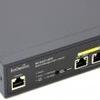Management and UI
Management and UI
With this switch you'll get a handful of control (UI) based. The regular Layer 2 web interface, as well as Enginius Cloud-based operation. We'll first look at the classic web-based management interface.
Web-Based Management
The classic web interface works well, really well. Mostly just as well as the cloud-based option, just that UI is in an older jacket so to say. I was surprised by the degree of (re)configurability available in the user interface.
You'll quickly learn that there are two system image partitions on the onboard flash storage: a primary (active) partition and a backup partition. This functionality alone indicates that this is an enterprise-class switch that has been designed with robustness in mind. Name it and it's there; Access Control Lists (ACLs) are collections of Access Control Entries that are controlled by the user (ACEs).
If you quickly need to know what port is connected at a certain speed, it's all available. Also, the ability to diagnose cable problems is a useful feature. Individual conductor pair status and estimated cable length are displayed on a pair-by-pair basis.
Quite possibly not as accurate as a cable tester, but if you're having trouble getting a cable to function, you can at the very least check for a miswire using this method:
Cloud based operation
Cloud management is as simple as adding the ECS2512FP with your EnGenius Cloud account and you are ready to go. Please do take note that the switch needs open ports 80 and 443. Behind a LAN your router should point to it, in a datacenter environment, a static IP would be nice.
Once setup icons provide an instantaneous overview of the status of each port, as well as the speed at which it is connected. The charts below show the total PoE consumption in relation to the switch's power budget, as well as the individual power consumption of each port. Also nice to see, the uplink (WAN pointing side) is listed with a small arrow in the connected port.
You'll see 5G and 10G mentioned as well, this of course is available at your disposal once you accept the SFP (transceiver) modules with a 10G SFP+ Module. These can be expensive btw, starting at 55 USD a pop.
Once in the cloud interface, you can and should immediately upgrade your firmware and from here onwards a plethora of options become available. Whether to enable or disable the voice VLAN, manage QoS scheduling as well as jumbo frames, and restrict access to the switch's local web console from this screen. All port configurations, as well as port mirroring and link aggregation, can be configured remotely.









